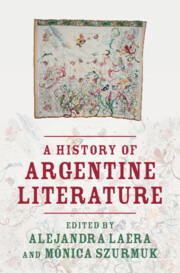Book contents
- A History of Argentine Literature
- A History of Argentine Literature
- Copyright page
- Contents
- Figures
- Contributors
- Editors’ Acknowledgments
- Introduction
- Part I Literary Dates
- Chapter 1 1536: The Creation of a Literary Space
- Chapter 2 1810: Patriotic Voices
- Chapter 3 1837: The Foundation of a National Literature
- Chapter 4 1884: A Literary Field in Formation
- Chapter 5 1910: A Modern Lettered City
- Chapter 6 1926: Traditions Old and New
- Chapter 7 1948: Culture and the State
- Chapter 8 1963: Experimentation and the Common Reader
- Chapter 9 1980: Memory and the Novel
- Chapter 10 2001: Argentine Narrative in the New Millennium
- Part II Critical Inroads
- Part III Literary Names
- Index
- References
Chapter 10 - 2001: Argentine Narrative in the New Millennium
from Part I - Literary Dates
Published online by Cambridge University Press: 09 May 2024
- A History of Argentine Literature
- A History of Argentine Literature
- Copyright page
- Contents
- Figures
- Contributors
- Editors’ Acknowledgments
- Introduction
- Part I Literary Dates
- Chapter 1 1536: The Creation of a Literary Space
- Chapter 2 1810: Patriotic Voices
- Chapter 3 1837: The Foundation of a National Literature
- Chapter 4 1884: A Literary Field in Formation
- Chapter 5 1910: A Modern Lettered City
- Chapter 6 1926: Traditions Old and New
- Chapter 7 1948: Culture and the State
- Chapter 8 1963: Experimentation and the Common Reader
- Chapter 9 1980: Memory and the Novel
- Chapter 10 2001: Argentine Narrative in the New Millennium
- Part II Critical Inroads
- Part III Literary Names
- Index
- References
Summary
The Argentine crisis of 2001 saw economic collapse, social unrest, and police repression. But if it caused a political and economic fracture with apocalyptic overtones, in literature – and in prose fiction, specifically – it did not mean a complete break with the past nor an eruption of the new, but instead the return or reformulation of the old. Despite everything, the 2000s was a period of productivity and global acclaim for Argentina’s writers. Certain activist uses of literature and its insertion in other areas of social praxis coexisted with a search for a personal voice, namely autofictions, writings of the self, and stories of everyday life. This chapter structures a reading of the literature of the 2000s around three key topics that emerge from this conjuncture: an aesthetic of recycling; an aesthetic of haunting; and the presence of a reinvigorated feminist gaze. After a period of scepticism about the role of literature in social change, these trends sparked a renewal of interest in the activist uses of fiction. At the same time, other writers made abject characters the protagonists of their stories and agitated for a literature that strives to be both autonomous and political at the same time.
- Type
- Chapter
- Information
- A History of Argentine Literature , pp. 147 - 162Publisher: Cambridge University PressPrint publication year: 2024

